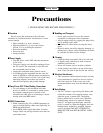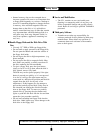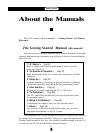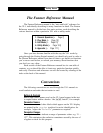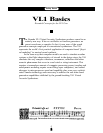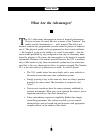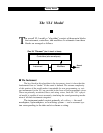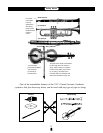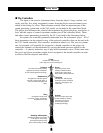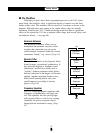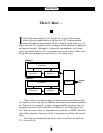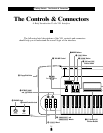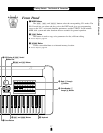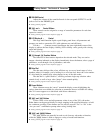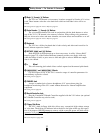
12
Getting Started
●
The Controllers
The input to an acoustic instrument comes from the player’s lungs, trachea, oral
cavity, and lips. In a string instrument it comes from the players arm movement, trans-
mitted to the string via a bow. These elements actually form an important part of the
sound generating system and, in the VL1 model, are included in the controllers block.
The player also influences the sound of the instrument by playing the keys, tone holes, or
frets, and this aspect of control constitutes another part of the controllers block. These
and other control parameters provided by the VL1 are listed in the illustration below.
In essence, the controller parameters determine how the instrument “plays”. All of
these parameters can be assigned to any of the external controllers that can be used with
the VL1: breath controller, foot controller, modulation wheels, etc. The pressure param-
eter, for example, will normally be assigned to a breath controller so the player can
control the dynamics of the instrument by varying the breath pressure applied to the
controller — a natural, instinctive way to play wind-instrument voices. At the same time
the growl and throat parameters might also be assigned to the breath controller in order
to achieve life-like response and effects.
Pressure
The amount of breath pressure
applied to the reed or mouthpiece,
or bow velocity applied to the string".
Embouchure
The tightness of the lips against
the reed or against each other, or
the force of the bow against the
string.
Pitch
Changes the length of the
air column or string, and thereby
the pitch of the sound.
Tonguing
Simulates the half-tonguing
technique used by saxophone
players by changing the "slit"
of the reed.
Scream
Drives the entire system into
chaotic oscillation, creating
effects that can only be
achieved with physical
modelling technology.
Growl
A periodic pressure (bow
velocity) modulation which
produces the "growl" effect
often heard in wind instruments.
Throat
Controls the characteristics
of the "player's" throat or bowing arm.
Damping & Absorption
Simulate the effects of air friction
in the pipe or on the string,
and of high-frequency losses
at the end of the pipe or string.



